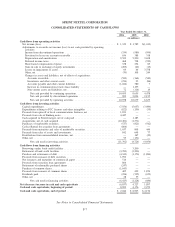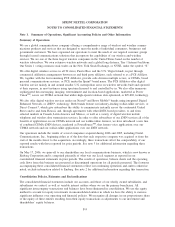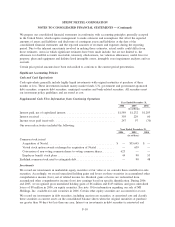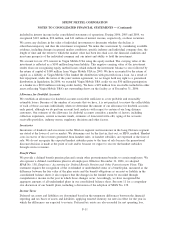Sprint - Nextel 2006 Annual Report Download - page 90
Download and view the complete annual report
Please find page 90 of the 2006 Sprint - Nextel annual report below. You can navigate through the pages in the report by either clicking on the pages listed below, or by using the keyword search tool below to find specific information within the annual report.We review our long-lived assets for impairment whenever events or changes in circumstances indicate that the
carrying amount may not be recoverable. A significant amount of judgment is involved in determining the
occurrence of an indicator of impairment that requires an evaluation of the recoverability of our long-lived
assets. If the total of the expected undiscounted future cash flows is less than the carrying amount of our
assets, a loss, if any, is recognized for the difference between the fair value and carrying value of the assets.
Impairment analyses, when performed, are based on our current business and technology strategy, our views of
growth rates for our business, anticipated future economic and regulatory conditions and expected technolog-
ical availability. For software projects that are under development, we periodically assess the probability of
deployment into the business to determine if an impairment charge is required.
We adopted Financial Accounting Standards Board, or FASB, Interpretation No. 47, or FIN 47, Accounting for
Conditional Asset Retirement Obligations, an interpretation of Statement of Financial Accounting Standards,
or SFAS, No. 143, Accounting for Asset Retirement Obligations, in the fourth quarter 2005 resulting in a
cumulative adjustment due to a change in accounting principle, after tax, of $16 million. The adjustment was
due to the recognition of asset retirement obligations primarily related to our discontinued operations for
environmental remediation requirements and contractual obligations for which estimated settlement dates can
be determined.
Intangible Assets
Goodwill and Other Indefinite Lived Intangibles
We have identified our licenses to use wireless spectrum issued by the Federal Communications Commission,
or FCC, and our Sprint and Boost Mobile trademarks as indefinite lived intangible assets, in addition to our
goodwill, after considering the expected use of the assets, the regulatory and economic environment within
which they are being used, and the effects of obsolescence on their use. We review our goodwill, which relates
solely to our wireless reporting unit, and other indefinite lived intangibles for impairment annually on
October 1, or more frequently if indicators of impairment exist. We continually assess whether any indicators
of impairment exist. A significant amount of judgment is involved in determining if an indicator of impairment
has occurred. Such indicators may include a sustained, significant decline in our share price and market
capitalization, a decline in our expected future cash flows, a significant adverse change in legal factors or in
the business climate, unanticipated competition, the testing for recoverability of a significant asset group
within a reporting unit, and/or slower growth rates, among others.
When required, we first test goodwill for impairment by comparing the fair value of our wireless reporting
unit with its carrying amount. If the fair value of the wireless reporting unit exceeds its carrying amount,
goodwill is not deemed to be impaired, and no further testing would be necessary. If the carrying amount of
our wireless reporting unit were to exceed its fair value, we would perform a second test to measure the
amount of impairment loss, if any. To measure the amount of any impairment loss, we would determine the
implied fair value of goodwill in the same manner as if our wireless reporting unit were being acquired in a
business combination. Specifically, we would allocate the fair value of the wireless reporting unit to all of the
assets and liabilities of that unit, including any unrecognized intangible assets, in a hypothetical calculation
that would yield the implied fair value of goodwill. If the implied fair value of goodwill is less than the
recorded goodwill, we would record an impairment charge for the difference.
When required, we test other indefinite lived intangibles for impairment by comparing an asset’s respective
carrying value to estimates of fair value, determined using the direct value method. Our FCC licenses are
combined as a single unit of accounting following the unit of accounting guidance as prescribed by Emerging
Issues Task Force, or EITF, Issue No. 02-7, Unit of Accounting for Testing Impairment of Indefinite-Lived
Intangible Assets, except for our FCC licenses in the 2.5 gigahertz, or GHz, band, which are tested separately.
See note 7 for additional information on our goodwill and other indefinite lived intangible assets.
F-13
SPRINT NEXTEL CORPORATION
NOTES TO CONSOLIDATED FINANCIAL STATEMENTS — (Continued)
























